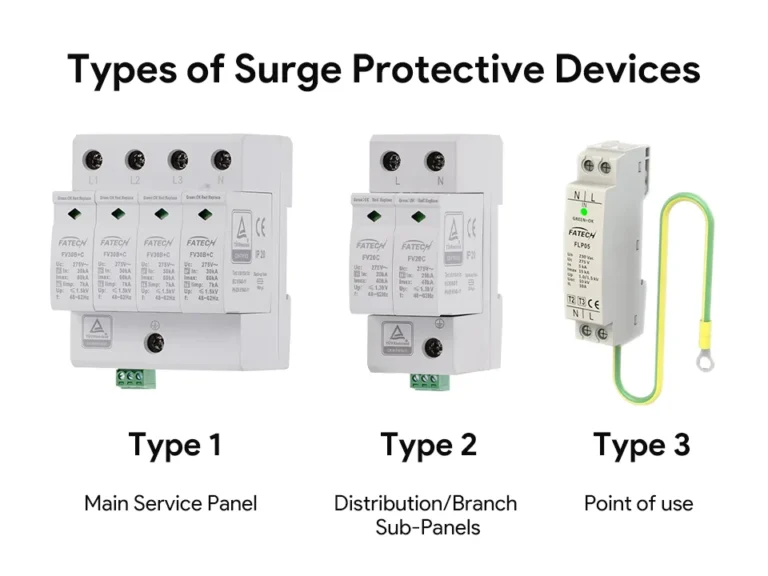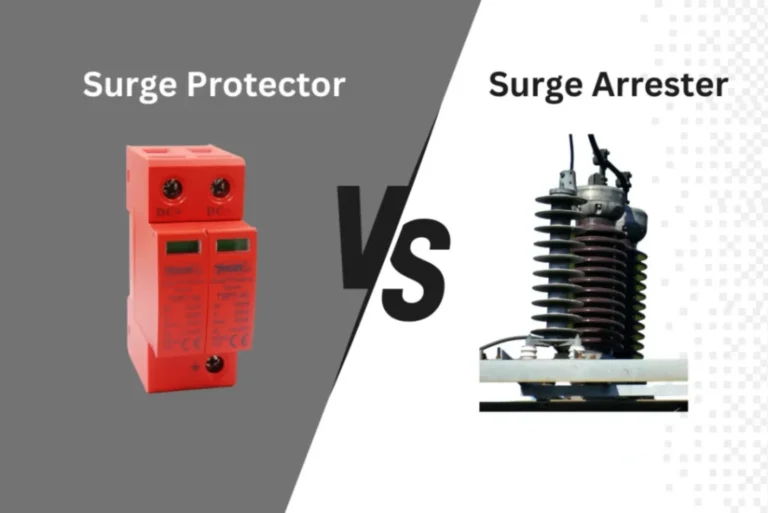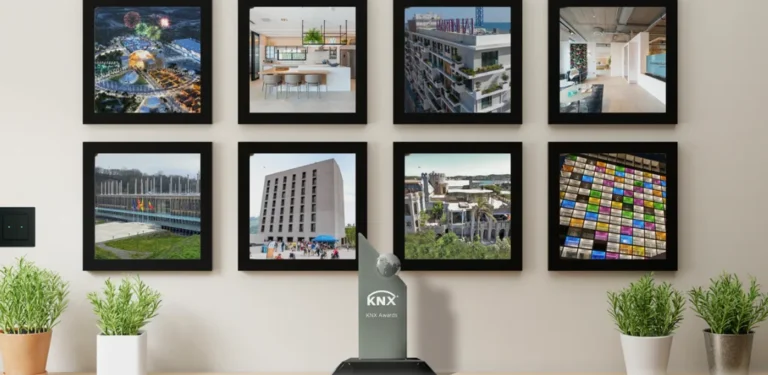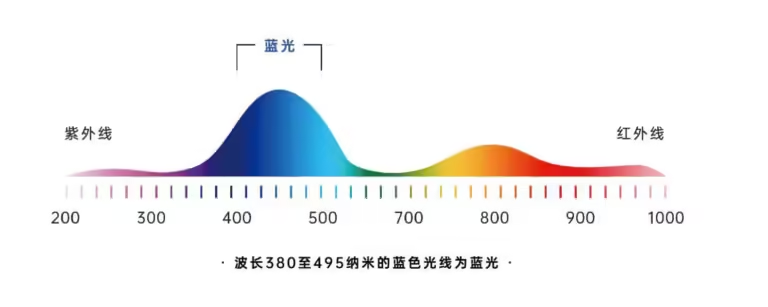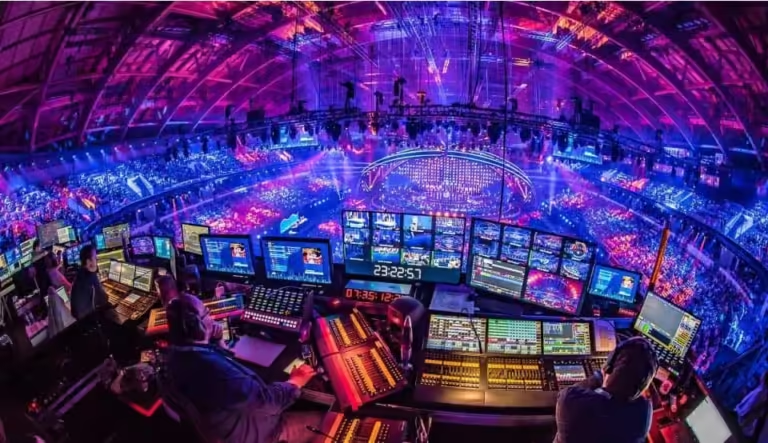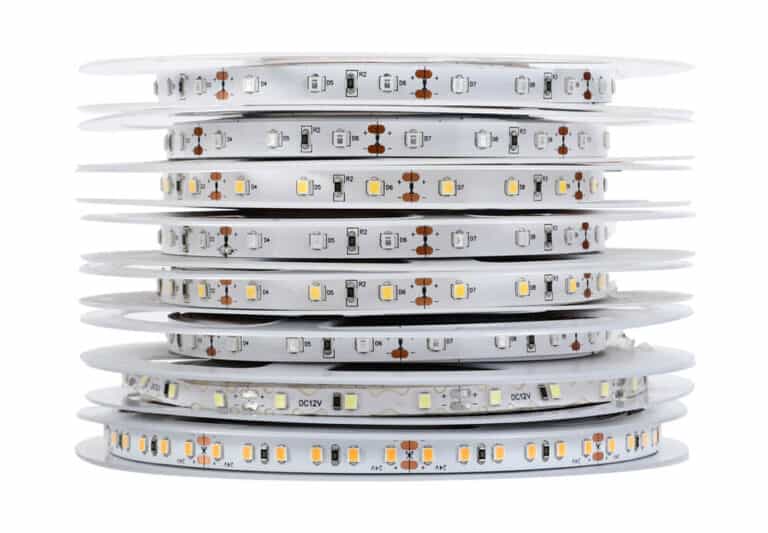Have you ever wondered why your LED lights sometimes fail much earlier than expected, even though they are labeled to last for 30,000 or even 50,000 hours? Or why street lights or facade lighting systems can suddenly go dark after a thunderstorm?
The truth is, LED technology is highly efficient but also very sensitive to power surges. Even a short electrical spike — caused by lightning, unstable grids, or heavy machinery switching on and off — can damage the delicate LED driver inside your fixtures. Once the driver fails, the entire luminaire is at risk.
This is where a Surge Protective Device (SPD) for LED lighting comes into play. Think of it as an insurance policy for your lighting system. Whether it’s LED linear lights, tube lights, or Tri-proof Lights in commercial spaces, or outdoor LED street lights on a highway, the right LED surge protection device can not only extend the lifespan of your fixtures and reduce unexpected failures, but also save you significant maintenance and replacement costs.
So, do all LED lighting projects really need surge protection? The short answer is yes — especially if you are working with commercial, industrial, or outdoor applications. Investing in SPD today can prevent costly downtime and keep your lighting projects running smoothly for years to come.
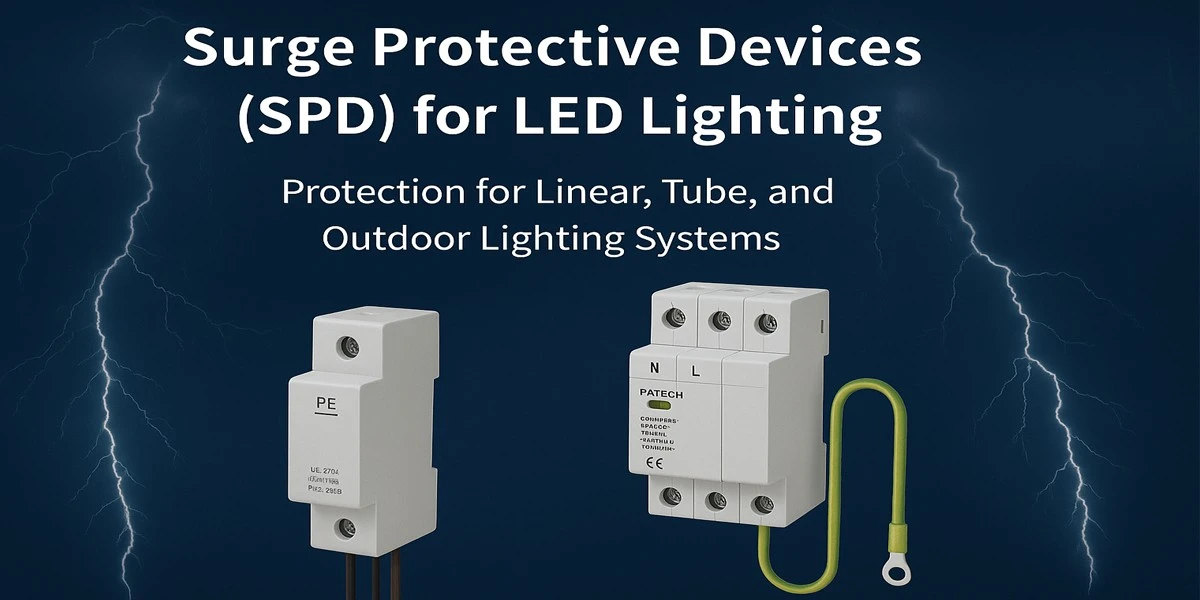
What is a Surge Protective Device (SPD) for LED Lighting?
What is SPD in LED Light?
A Surge Protective Device (SPD) is a critical component designed to protect LED lighting systems from sudden voltage spikes that can damage drivers and LEDs. In most LED fixtures, the driver converts AC mains power into a stable DC output for the LEDs. Even a brief electrical surge — from lightning, grid instability, or heavy equipment switching — can overload and permanently damage the driver, leading to fixture failure and additional maintenance costs.
SPD acts like a safety valve, diverting excess voltage safely to the ground or neutral line before it reaches sensitive components. This protection is essential not only for outdoor LED street lights and facade lighting but also for indoor LED linear lights, tube lights, and shelf lighting in commercial spaces. Installing an appropriate SPD enhances reliability, reduces downtime, and saves maintenance and replacement costs.
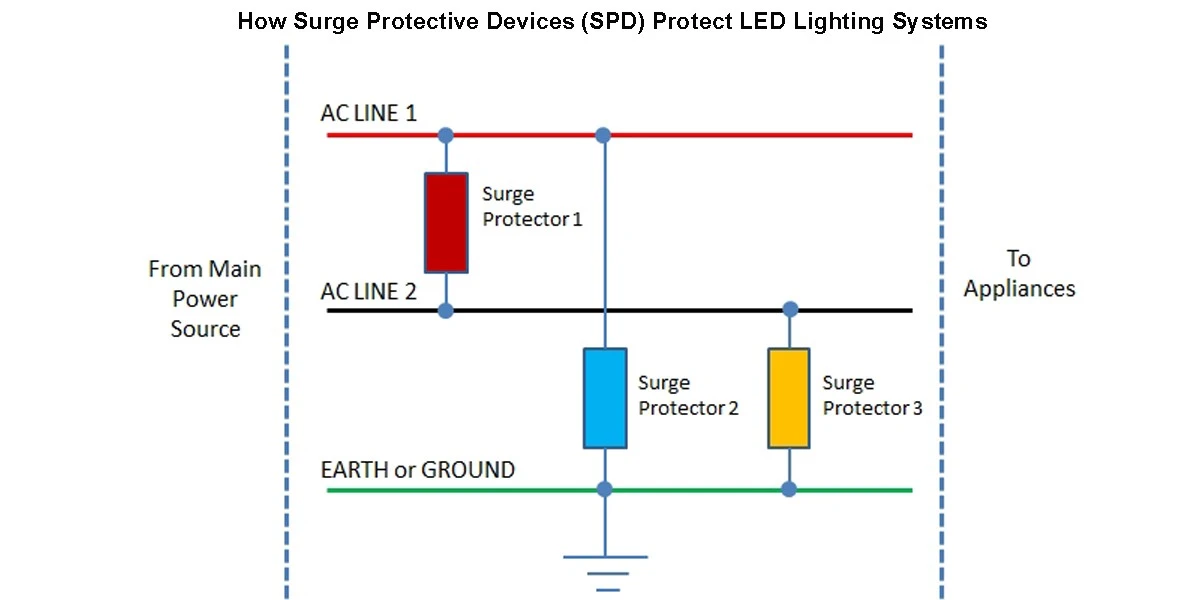
Types of Surge Protection Devices for LED Lights
SPDs come in three main types, each suited to different applications:
Replaceable SPDs – modular and replaceable, allowing damaged units to be swapped quickly, minimizing downtime and maintenance costs.
Internal SPDs – integrated into the LED driver or fixture. Ideal for compact linear lights, tube lights, or shelf lighting where external installation is impractical.
External SPDs – installed on the mains input line outside the fixture. Common for high-power indoor lighting or outdoor applications such as street lights and facade lighting.
Professional-grade SPDs comply with international standards such as IEC 61643-11 and UL 1449, ensuring consistent performance and safety. Choosing the right type of SPD not only protects your LED lighting but also maximizes investment value by extending fixture lifespan and reducing unexpected costs.
Types of Electrical Surges and How LED Surge Protectors Work
Electrical surges can affect LED lighting systems in different ways. Understanding the types of surges and how Surge Protective Devices (SPD) work is crucial for ensuring reliable operation.
Types of Electrical Surges
Common-Mode Surge (CM) – Occurs when both phase and neutral lines rise together relative to ground. These surges often result from lightning strikes or grid switching and can damage sensitive LED drivers if not properly protected.
Differential-Mode Surge (DM) – Occurs between phase and neutral lines. Typically caused by switching of heavy equipment or internal facility loads, DM surges may lead to flickering, driver failure, or permanent LED damage.

Common-Mode and Differential-Mode Surge Paths in LED Lighting Circuits
How SPD Protects LED Lighting
An SPD safeguards LED systems by diverting excess voltage and current away from sensitive components. The process generally involves:
- Detection – The SPD detects voltage exceeding its normal operating range.
- Clamping – Using components like MOVs (Metal Oxide Varistors), TVS diodes, or gas discharge tubes, the voltage is limited to a safe level.
- Diverting Surge Current – Excess current is safely channeled to ground or neutral lines, preventing damage to the LED driver and fixtures.
Key Benefits of Proper SPD Installation:
Ensures stable operation for indoor and outdoor LED lighting
Protects against both common-mode and differential-mode surges
Prevents LED driver failure and component damage
Reduces maintenance and replacement costs

Why LED Lighting Needs Surge Protection?
Why Surges Are a Risk for LED Lighting
LED lights are highly efficient, long-lasting, and energy-saving, but their electronics are sensitive to voltage fluctuations. Even a short-lived surge — caused by lightning, unstable grids, or heavy equipment switching — can overload the LED driver, damage internal components, and lead to premature failure.
Indoor lighting such as LED linear lights, tube lights, and shelf lights in commercial spaces is also at risk, especially in areas with frequent electrical disturbances. Outdoor lighting like LED street lights and facade lighting faces additional threats from lightning strikes and weather-related voltage spikes. Without proper protection, these surges can result in:
- Reduced LED lifespan
- Unexpected maintenance or replacement costs
- Potential downtime affecting business operations or safety
Installing a Surge Protective Device (SPD) for LED lighting mitigates these risks, ensuring reliable operation and long-term cost savings.
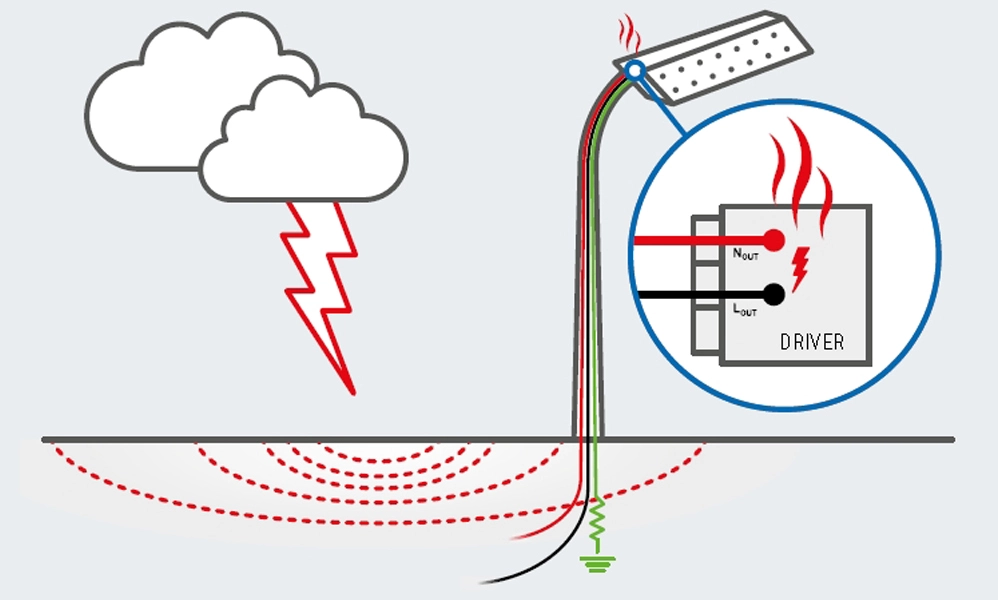
Figure: Diagram showing how lightning-induced surges affect LED drivers and fixtures.
Benefits of Surge Protection for LED Lighting
Adding SPD to your LED lighting system offers multiple advantages for both indoor and outdoor projects:
- Extended LED Lifespan – SPDs prevent damage from voltage spikes, allowing LEDs to reach their designed operational hours.
- Reduced Maintenance Costs – By avoiding unexpected failures, SPDs minimize service calls and replacement frequency.
- Enhanced Reliability – Protecting sensitive components ensures continuous operation for critical lighting applications.
- Cost-Effective Investment – Although SPDs add an initial cost, the savings from reduced maintenance, fewer replacements, and avoided downtime usually pay off quickly, maximizing return on investment.
This is especially important for commercial facilities, industrial plants, retail environments, and outdoor installations where LED lighting is a significant investment.
LED Surge Protection Products Overview & Selection Guide
Selecting the right Surge Protective Device (SPD) is essential to protect your LED lighting investment, reduce downtime, and extend the lifespan of your fixtures. Below is an overview of typical SPD products along with practical selection guidance.
Product Overview
SPDs are widely used across various LED applications, including linear lights, tube lights, shelf lighting, street lights, and facade lighting. Modern SPDs may be internal, external, or modular/replaceable, designed to suit different installation scenarios and maintenance requirements.
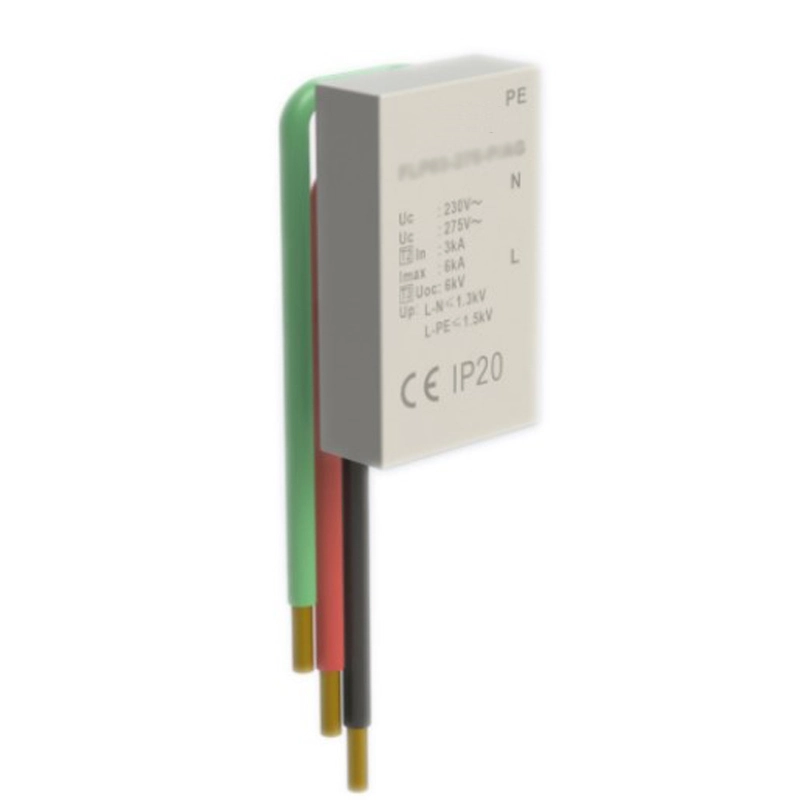
Surge protective device for LED lighting
SPD protection conforms to EN 61643-11: Type2+3
SPD installation type conforms to EN 61643-1: ClassII+III
Protection level conforms to DIN VED 0675-6: C+D
Protection mode: L-N , N-PE ,L-PE
Nominal Voltage 50(60)Hz UN: 230 V~
Maximum continuous operating voltage UC: 275 V~
Maximum discharge current (8/20μs) Imax: 6 kA
Nominal discharge current (8/20μs) In: 3 kA
Voltage protective level Up: L-N≤1.3kV / L(N)-PE≤1.5 kV
Open circuit voltage Uoc: 6 kV
Response time tA: L-N≤25 ns/ N-PE ≤100 ns
Recommended back-up fuse: 16 AgL/gG
Thermal Cut-off Member: YES
Disconnection indicator : Without
Housing material: UL94V-0
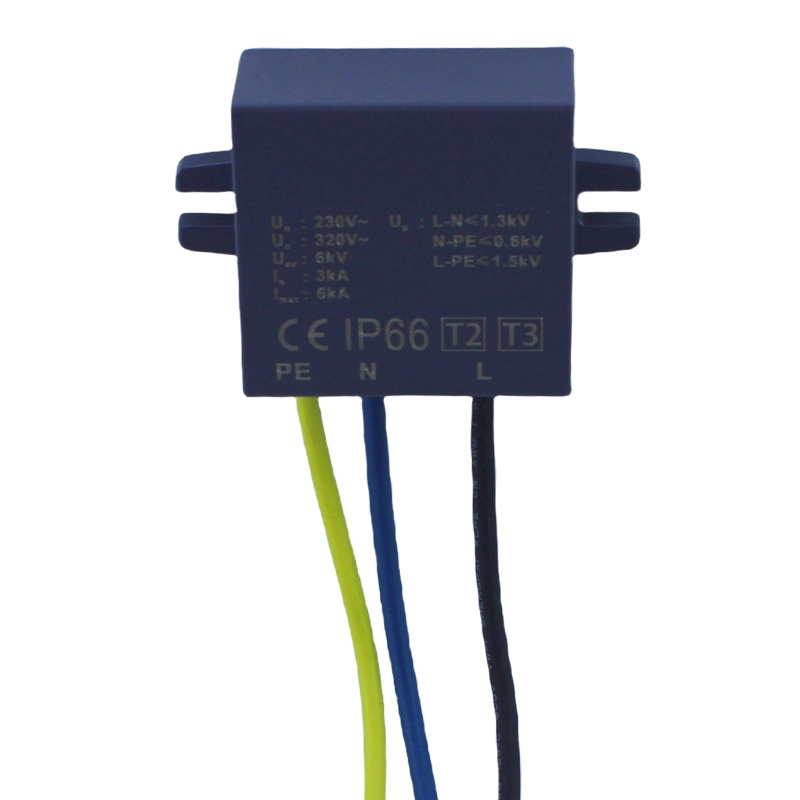
DC Surge protective device for LED lighting
SPD protection conforms to EN 61643-11: Type2+3
SPD installation type conforms to EN 61643-1: ClassII+III
Protection level conforms to DIN VED 0675-6: C+D
Protection mode: L-N , N-PE ,L-PE
Nominal Voltage 50(60)Hz UN: 230 V~
Maximum continuous operating voltage UC: 320 V~
Maximum discharge current (8/20μs) Imax: 6 kA
Nominal discharge current (8/20μs) In: 3 kA
Voltage protective level Up: L-N≤1.5kV/ N-PE≤0.6kV/ L-PE≤1.5kV
Open circuit voltage Uoc: 6 kV
Response time tA: L-N≤25 ns/ N-PE ≤100 ns
Recommended back-up fuse: 16 AgL/gG
Thermal Cut-off Member: YES
Disconnection indicator : Without
Housing material: UL94V-0
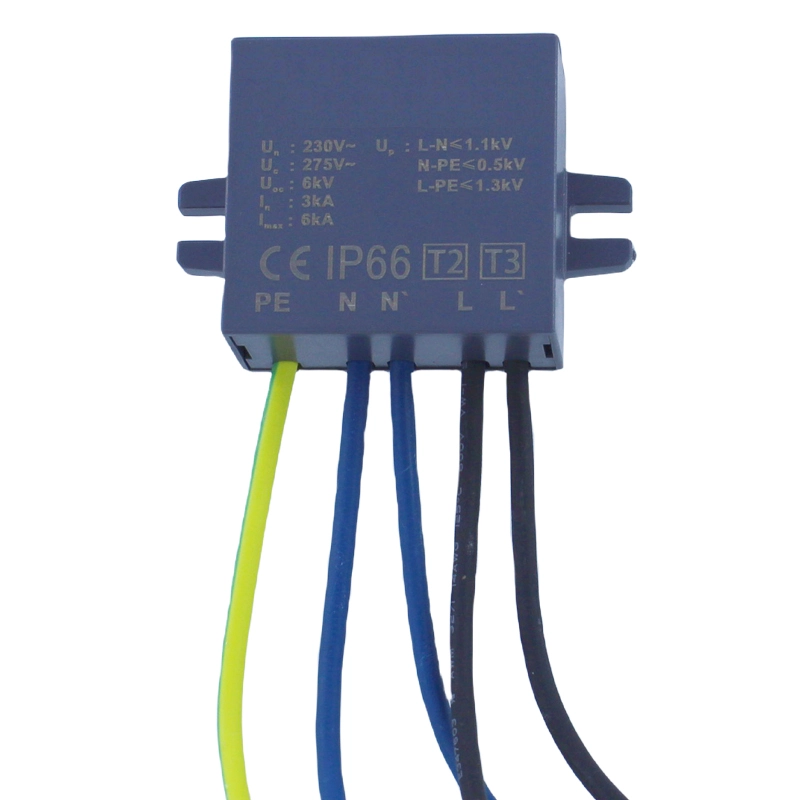
DC Surge protective device for LED lighting
SPD protection conforms to EN 61643-11: Type2+3
SPD installation type conforms to EN 61643-1: ClassII+III
Protection level conforms to DIN VED 0675-6: C+D
Protection mode: L-N , N-PE ,L-PE
Nominal Voltage 50(60)Hz UN: 230 V~
Maximum continuous operating voltage UC: 275 V~
Maximum discharge current (8/20μs) Imax: 6 kA
Nominal discharge current (8/20μs) In: 3 kA
Voltage protective level Up: L-N≤1.1kV/ N-PE≤0.5kV/ L-PE≤1.3kV
Open circuit voltage Uoc: 6 kV
Response time tA: L-N≤25 ns/ N-PE ≤100 ns
Recommended back-up fuse: 16 AgL/gG
Thermal Cut-off Member: YES
Disconnection indicator : Without
Housing material: UL94V-0
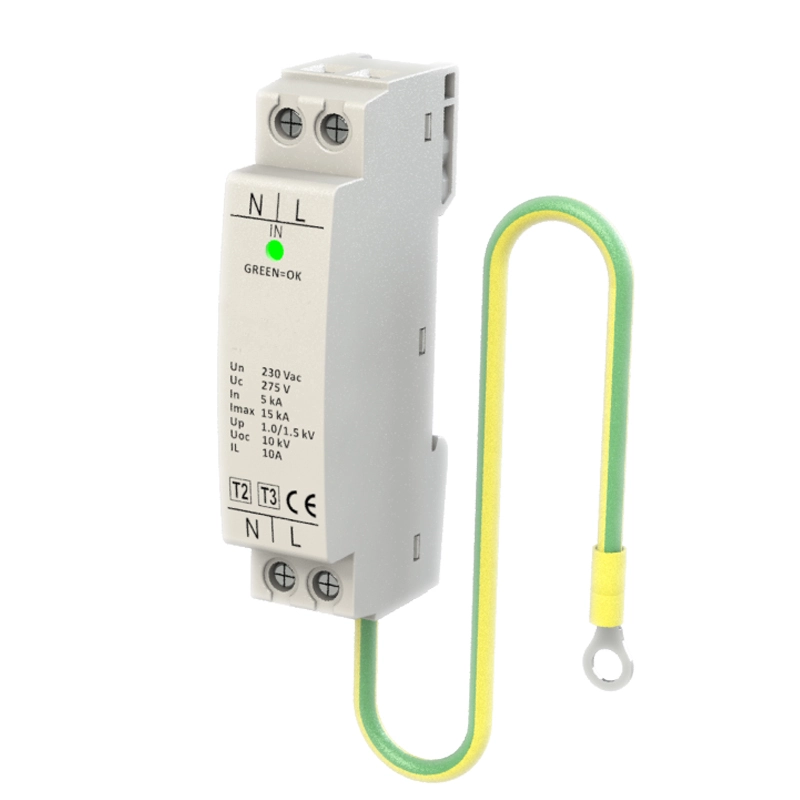
Surge protective device for LED lighting
SPD protection conforms to EN 61643-11: Type2+3
SPD installation type conforms to EN 61643-1: ClassII+III
Protection level conforms to DIN VED 0675-6: C+D
Protection mode: L-N , N-PE ,L-PE
Nominal Voltage 50(60)Hz UN: 230 V~
Maximum continuous operating voltage UC: 275 V~
Maximum discharge current (8/20μs) Imax: 15 kA
Nominal discharge current (8/20μs) In: 5 kA
Voltage protective level Up: L-N≤1.3kV/ N-PE≤0.5kV/ L-PE≤1.5kV
Open circuit voltage Uoc: 10 kV
Response time tA: L-N≤25 ns/ N-PE ≤100 ns
Recommended back-up fuse: 20 AgL/gG
Thermal Cut-off Member: Internal
Disconnection indicator : LED indicator
Housing material: UL94V-0
Recommended SPD Models for LED Lighting
| Model | Type | Voltage Rating | Max Surge Current (Imax) | Key Features | Typical LED Applications |
| SPD03-AC275-P/AG | AC SPD | 230 V AC | 6 kA | Type 2+3, Class II+III, Up ≤ 1.3 kV | LED linear lights, shelf lighting, indoor fixtures |
| SPD03-DC320-P/G | DC SPD | 320 V DC | 6 kA | Up ≤ 1.5 kV, fast response < 25 ns | Low-voltage or solar-powered LED systems |
| SPD03-DC275-S/G | DC SPD | 275 V DC | 6 kA | Up ≤ 1.1 kV, high stability | DC LED strips, signage, or display modules |
| SPD05-AC275i-D | AC SPD | 230 V AC | 15 kA | Built-in thermal cutoff, LED indicator | Street lights, facade lighting, industrial floodlights |
Selection Tips
- Match SPD type to power system: AC SPD for standard mains, DC SPD for constant-voltage LED systems.
- Align voltage rating with driver input (230 V AC, 275–320 V DC).
- Use higher Imax (≥10 kA) for outdoor, high-risk environments.
- Ensure compliance with EN 61643-11, IEC 61643-1, DIN VED 0675-6, and other regional safety standards.
- For easy maintenance, select models with LED disconnection indicators or replaceable modules.
Key Advantages
- Comprehensive protection against common-mode and differential-mode surges.
- Prevents LED driver failure and component damage.
- Reduces maintenance and replacement costs.
- Supports stable performance in indoor and outdoor LED applications.
Applications & Installation Tips
Proper application and installation of Surge Protective Devices (SPDs) are essential to ensure long-term protection for LED lighting systems. Here’s how SPDs are commonly applied and installed:
Indoor Linear Lights & Shelf Lighting
Application: Protects LED modules and drivers in offices, retail shelves, and display cases.
Installation Tips:
- Use internal SPDs for compact fixtures where space is limited.
- Ensure the SPD is installed close to the driver to minimize voltage drop.
- Check the wiring polarity and secure connections to prevent loose contacts.
Tube Lights & Panel Lights
Application: Safeguards LED tube lights and panel lights in commercial spaces.
Installation Tips:
- Modular or replaceable SPDs are recommended for easy maintenance.
- Confirm rated voltage and surge current match the LED fixture specifications.
- Ensure adequate ventilation around SPD to prevent overheating.
Outdoor & Industrial Lighting (Street, Facade, Stadium)
Application: Protects against lightning strikes, grid switching, and power fluctuations.
Installation Tips:
- Use external or industrial-grade SPDs with higher surge current ratings.
- Proper grounding and bonding are essential for effective surge diversion.
- Consider IP and IK ratings of SPD housing to withstand environmental and mechanical stress.
General Best Practices
Always follow manufacturer installation instructions.
Record installation details for maintenance, inspection, and warranty purposes.
Periodically inspect and test SPDs to ensure ongoing performance.
Plan SPD locations to cover the most vulnerable points in the lighting system.
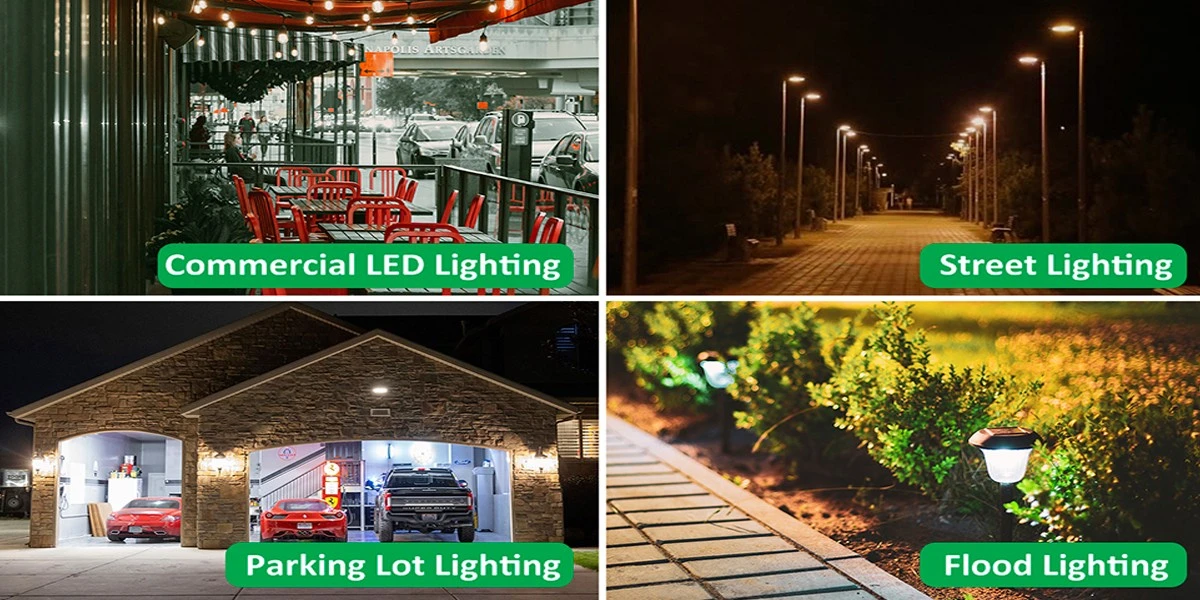
Trends in LED Surge Protection
The global LED surge protector market was valued at around US$ 384 million in 2024, and is projected to grow to US$ 683 million by 2032, with a compound annual growth rate (CAGR) of approximately 7.5 % over the period 2025–2032.
This growth is driven by several key trends and market forces:
1. Surge in LED adoption & smart city infrastructure
- As cities upgrade to LED-based street lights, façade lighting, and smart lighting systems, demand for reliable protection increases.
- LED already dominates a large share of new lighting installations because of its energy efficiency, which increases the importance of surge protection.
2. Shift toward smart and integrated protection
- Modern SPDs increasingly embed monitoring, remote diagnostics, and communication capabilities, making them integral parts of smart lighting networks.
- Hybrid protection designs—combining MOVs, gas discharge tubes, and other elements—are emerging to balance speed, robustness, and cost.
3. Higher surge ratings & modular design
- Outdoor and critical installations demand SPDs with higher current ratings (e.g. 20 kA, 40 kA甚至更高) to withstand more extreme surge events.
- Modular and replaceable SPD designs gain traction for easier maintenance and lower downtime costs.
- Compact SPDs for integration into slim lighting profiles become a competitive advantage in LED fixture design.
4. Regional growth shift & market dynamics
- Asia-Pacific, led by China, is the fastest-growing region in LED surge protector demand, thanks to rapid urbanization and large-scale infrastructure projects.
- North America holds a large share (e.g. ~32.7%) of the market in 2024, driven by strict electrical safety regulations and high LED penetration.
5. Challenges: cost sensitivity & standardization gaps
- In many price-sensitive markets, the additional cost of integrating surge protection — which can increase total system cost by 15–20% — still slows wider adoption of SPDs.
- Lack of uniform testing and certification standards for LED-specific SPDs introduces uncertainty in product comparisons.
- Miniaturization of LED fixtures constrains internal space for SPD components, pushing innovation for compact yet high-performance designs.
6. Implications for LED Lighting Projects
- Designers and specifiers should anticipate increasing norm of including SPD in all lighting projects, especially outdoor and façade work.
- Smart lighting projects should mandate SPDs with communication or status feedback capability.
- Manufacturers that can deliver high-performance, compact, modular, cost-efficient SPDs will have a competitive edge.
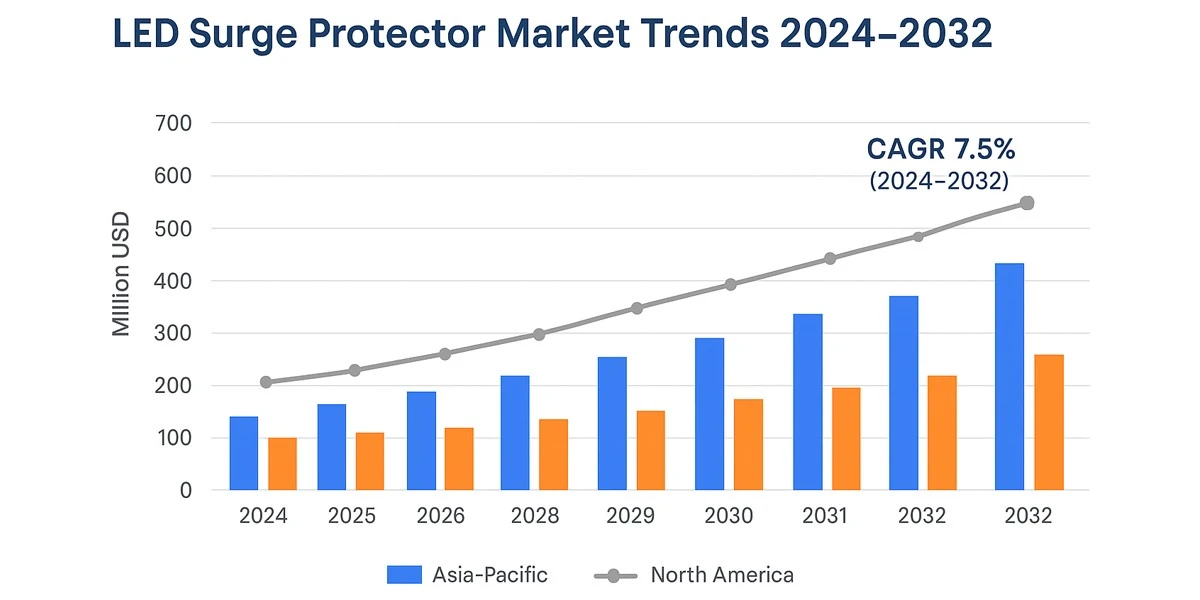
Conclusion: Reliable SPD, Reliable LED System
A well-designed Surge Protective Device (SPD) is not just an optional accessory — it’s a vital safeguard that determines the longevity, reliability, and performance of your LED lighting system. Whether you’re designing indoor linear lights, outdoor façade lighting, or commercial shelf lights, integrating the right SPD can save you from costly replacements and downtime.
By selecting industry-tested surge protectors with proper voltage ratings, fast response time, and modular design, lighting manufacturers and project contractors can achieve both cost efficiency and long-term stability.
If you’re sourcing reliable SPD solutions for LED lighting, SignliteLED offers a full range of integrated protection systems tailored to linear, tube, and retail display lighting — helping you deliver safer, longer-lasting illumination for every project.
Contact us today to learn more about customized surge protection solutions for your LED lighting applications.
